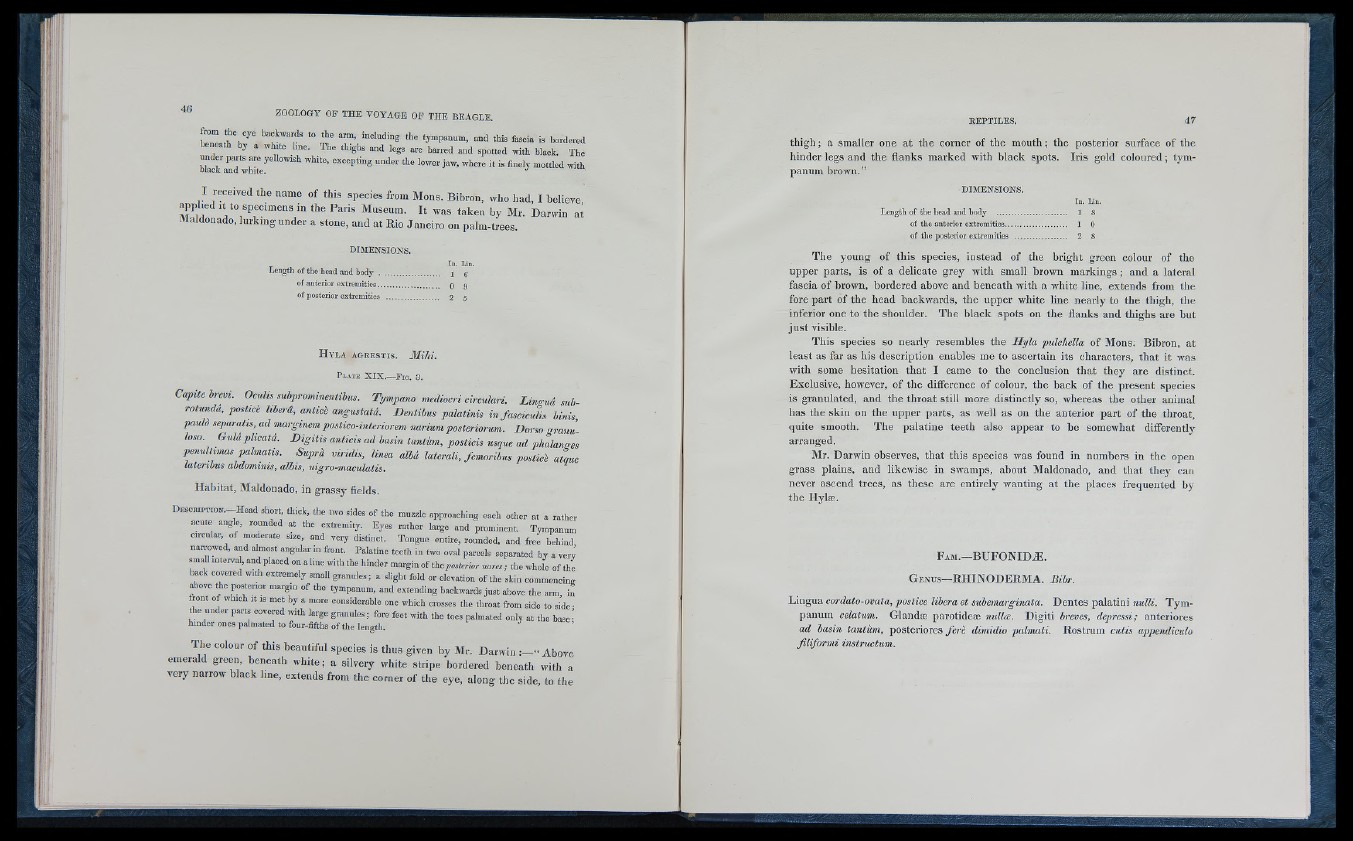
from the eye b a c kw a rd ,o th e arm, in elu d in g th e tym p an um , an d this faseia is bordered
ben e ath by a white line. T h e thighs an d legs are b arred an d sp o tte d w ith black. T h e
b laA a r d wh ite 1°’" “ J“""! '^ I'e re it is finely m o ttled with
I received the name of this species from Mons. Bibron, who had, I believe
applied It to specimens in the Paris Maseum. I t was taken by Mr. Darwin ai
Maldonado, lurking under a stone, and at Hio Janeiro on palm-trees.
DIMENSIONS.
In. Lin.
Lergtli of the liead and body j g
of anterior extremities q 9
of posterior extremities 2 5
H y l a a g r e s t i s . 3Iihi.
P late X IX .—F ig . 3.
Capite brevi. Oculis subprominentibus. Tympano mediocri circulari. Lino-ud sub
rotundd. posticè liberà, antieè angustatà. Dentibus palatinis in fa s c i J i s binis
paulo separatis, ad marginem postico-interiorem narium posteriorum. Dorso granilloso.
GuU plicatá. D ig itis anticis ad hasin tantùm, posticis usque ad plialanires
penultmms palmatis. Suprà viridis, linea albà Uterali, femoribus posticè ainue
lateribus abdominis, albis, nigro-maculatis.
Habitat, Maldonado, in grassy fields.
DESCIUPTI0N.--Head short, thiek. th e two sides o f th e muzzle approaching each o th e r a t a ra th e r
a cute angle, ro u n d e d a . th e extremity. E y e s ra th e r large an d p rom in en t. T ym panum
circular, o f modera te size, an d v e ry d istinct. T o n g u e en tire , ro u nded, a n d free behind
narrowed, an d almost angula r in front. P a la tin e te e th in two oval parcels sepa rated by a ver^
small tnlerval, an d p laced on a lin e with th e h in d e r margin o f tb e posterior nares; th e whole o f th i
b ack covered with extremely small g ra n n ie s ; a slight fold o r elevation o f th e skin commencing
above th e posterior m arg in o f th e tympanum, an d e x te n d in g backwards ju s t above th e arm i f
fro n t o f which it is m e t b y a more considerable one which crosses th e th ro a t from side to side •
th e u n d e r p a rts covered with large granule s ; fore fe et with the toes p alm ate d only a t th e base ^
h in d e r ones palmated to four-fifths o f th e length.
The colour of this beautiful species is thus given by Mr. Darwin “ Above
emerald green, beneath white; a silvery white stripe bordered beneath with a
very narrow black line, extends from the corner of the eye, along the side, to the
th ig h ; a smaller one a t the corner of the mouth; the posterior surface of the
hinder legs and the flanks marked with black spots. Iris gold coloured; tympanum
brown.”
DIMENSIONS.
In. Lin.
Length of the head and body ................................... 1 S
of the anterior extremities I 0
of the posterior extremities ........................... 2 8
The young of this species, instead of the bright green colour of the
upper parts, is of a delicate grey with small brown markings ; and a lateral
fascia of brown, bordered above and beneath with a wffiite line, extends from the
fore p a rt of the head backwards, the upper white line nearly to the thigh, the
inferior one to the shoulder. The black spots on the flanks and thighs are but
ju s t visible.
This species so nearly resembles the Hyla pulchella of Mons. Bibron, at
least as far as his description enables me to ascertain its characters, th a t it was
with some hesitation th a t I came to the conclusion th a t they are distinct.
Exclusive, however, of the difference of colour, the back of the present species
is granulated, and the throat still more distinctly so, whereas the other animal
has the skin on the upper parts, as well as on the anterior p a rt of the throat,
quite smooth. The palatine teeth also appear to be somewhat differently
arranged.
Mr. Darwin observes, th a t this species was found in numbers in the open
grass plains, and likewise in swamps, about Maldonado, and th a t they can
never ascend trees, as these are entirely wanting at the places frequented by
the Hyl«.
F a m .— BUFO N IDÆ.
G e n u s— RHINODERMA. Bibr.
Lingua cordato-ovata, postice libera et subemarginata. Dentes palatini nulli. Tympanum
celatum. Glandæ parotideæ nulloe. Digiti breves, depressi; anteriores
ad basin taniùni, posteriores ferh dimidio palmati. Rostrum cutis
filiformi instructum.